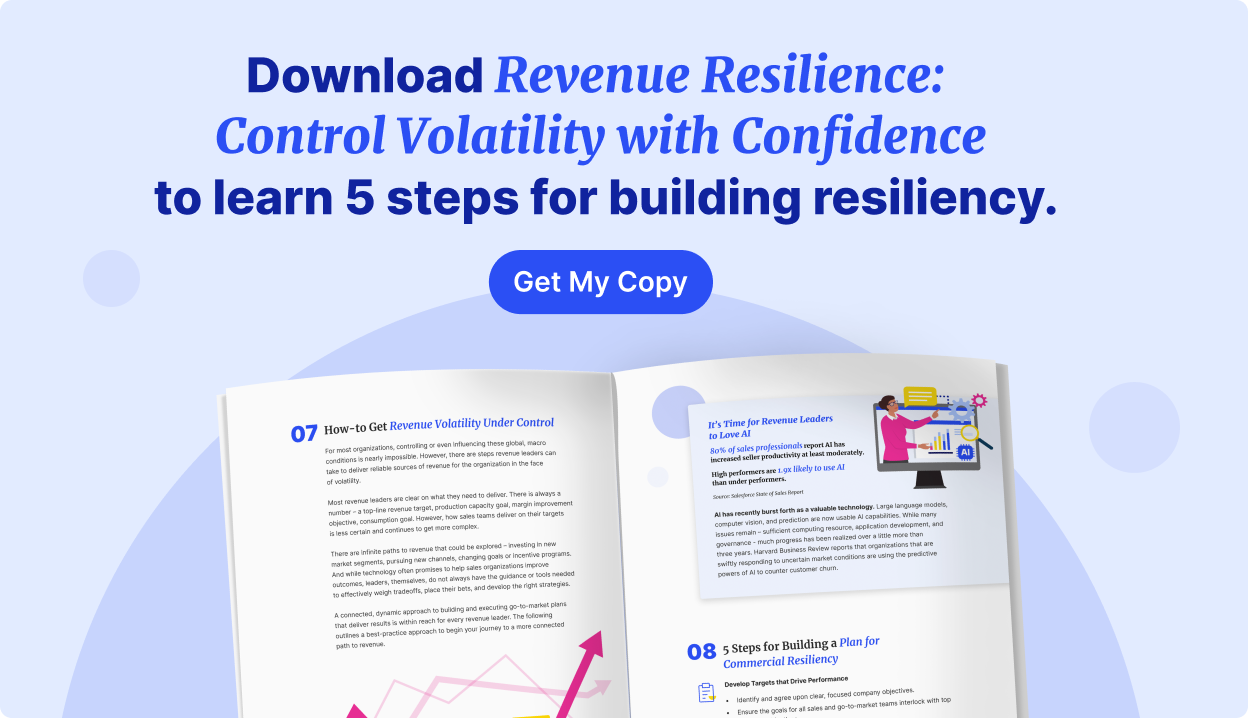Revenue volatility – two words that hit close to home for any sales professional in this disruptive market. Maintaining consistent revenue has become a delicate balance of strategy and adaptability.
Explore key indicators of revenue volatility and outline actions you can take to help mitigate revenue fluctuations with confidence.
What’s Causing the Market Disruption?
Picture the last four years: it’s been a whirlwind of challenges for sales professionals from all angles. The global health crisis, inflation, a potential recession, and intense competition are just a few factors causing instability. It’s no surprise that consumers and businesses are reassessing their spending habits, fostering a more risk-averse environment.
As if that wasn't enough, there is instability in the labor and talent markets. And companies are steadily decreasing their capital spending between now and 2025. It all leads to confusion over how to best lead and manage a business. Less than 50% of sellers in the past five years have hit their quotas. There’s uncertainty in where to invest, who to trust, and what’s going to happen next.
Measuring the Impact of Market Volatility: Fortune 500 Case Study
To shed more light on the issue, we took a closer look at the performance of Fortune 500 companies over the past decade. We examined their revenue volatility, measuring how much their revenue has fluctuated year to year.
Between 2013 and 2017, there was moderate fluctuation, with an average year-over-year change of 5.5%. However, from 2018 to 2022, you really start to see the spikes. The revenue volatility number more than doubled as external and internal factors became even more intense.
What does this tell us? It's evident that predicting or controlling revenue is more challenging today, than it has been over the last 10 years. And that’s really impacting sales leaders confidence moving forward.
So how can you be more confident in your planning and decision-making? The first step is try to get ahead of it.
Sales Operations KPIs: Early Warning Signs
To effectively tackle revenue volatility, it is essential to pay attention to the early warning signs. Harvard Business Review suggests when companies identify “trigger points, signposts, and metrics” to keep an eye on, it creates a competitive advantage. It gives you more agility to shift strategies before the competition is made aware.
Sales Key Performance Indicators (KPIs) that can indicate volatility:
1. Sales Revenue Figures
The monthly, quarterly, and annual revenue numbers are your North Star. Consistently monitor them to spot trends and irregularities.
2. Sales Growth Rates
A dip or surge in growth rates over time can indicate potential revenue volatility on the horizon.
3. Customer Retention Rates
High customer churn rates may suggest underlying problems affecting your revenue stream.
4. Revenue Concentration
Over-reliance on a few key customers can be risky. Diversify your customer base to mitigate the impact of sudden changes in their business circumstances.
5. Cash Flow Trends
Fluctuations in cash flow can disrupt your day-to-day operations and negatively impact revenue stability.
6. Sales Pipeline Health
The number of deals in your pipeline and their stages provide a glimpse into future revenue. An unhealthy pipeline could signify potential trouble.
7. Customer Demand Forecasts
Accurate forecasts help you anticipate shifts in demand and plan resources accordingly.
8. Customer Feedback and Complaints
Don't underestimate the power of customer sentiment. Early warnings from feedback and complaints can help you make necessary adjustments.
7 Actions to Navigate Revenue Volatility with Confidence
If the warning signs are there, here are 7 actions you can take to get back on track for predictable and sustainable revenue growth.
1. Data-Driven Decision-Making
Leverage the wealth of data at your fingertips to make informed decisions. Use advanced analytics tools to identify patterns and anticipate shifts.
Watch for more insight into the importance of data-driven decision-making.
2. Diversification is Key
Reduce the risk of revenue concentration by expanding your customer base. This acts as a buffer against the impact of a single customer's unpredictable decisions.
3. Strengthen Your Pipeline
Nurture a healthy sales pipeline. Consistent and strategic efforts ensure a steady stream of potential revenue, even when the tides turn.
4. Adaptive Forecasting
Embrace agile forecasting techniques. Regularly update your forecasts based on changing market dynamics and customer demands.
5. Customer-Centric Approach
Prioritize customer satisfaction and engagement. Happy customers are more likely to remain loyal, providing a stable revenue base.
Watch this clip to hear more about the importance of the customer journey.
6. Continuous Monitoring
Keep a vigilant eye on cash flow trends and customer retention rates. Detecting anomalies early allows for quick corrective action.
7. Collaborative Decision-Making
Encourage cross-functional collaboration between sales, marketing, and operations. Working together helps mitigate potential revenue shocks.
Embrace the Challenge, Empower Your Success
Stephen Hawking once said: “Intelligence is the ability to adapt to change.” The Fortune 500 data is clear – revenue volatility is real, and it's intensifying. However, challenges are the stepping stones to success. Data-driven insights, a customer-centric mindset, and a flexible approach can lead to predictable, stable revenue.





